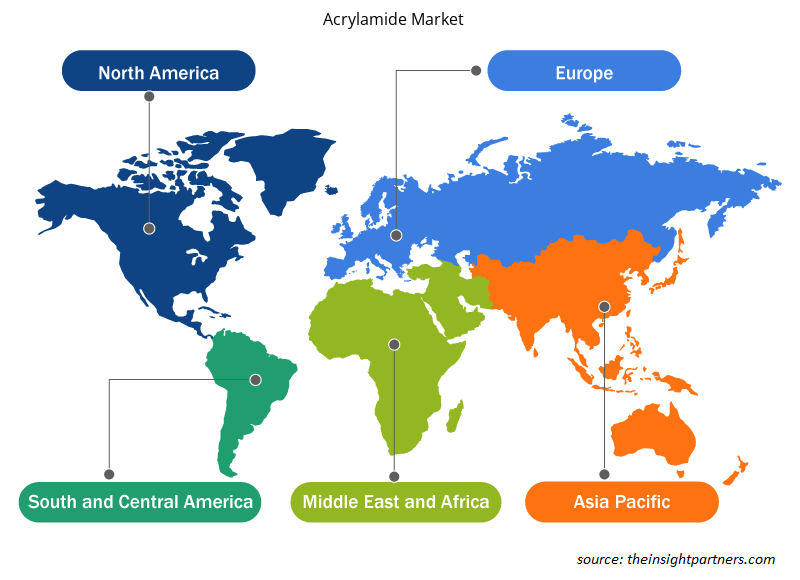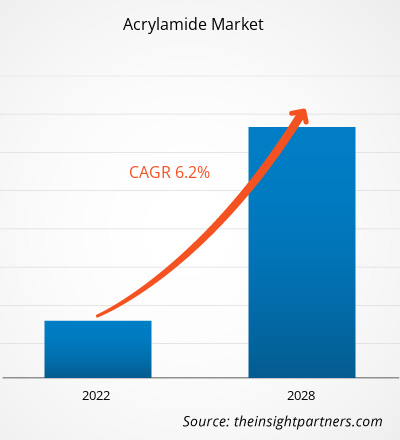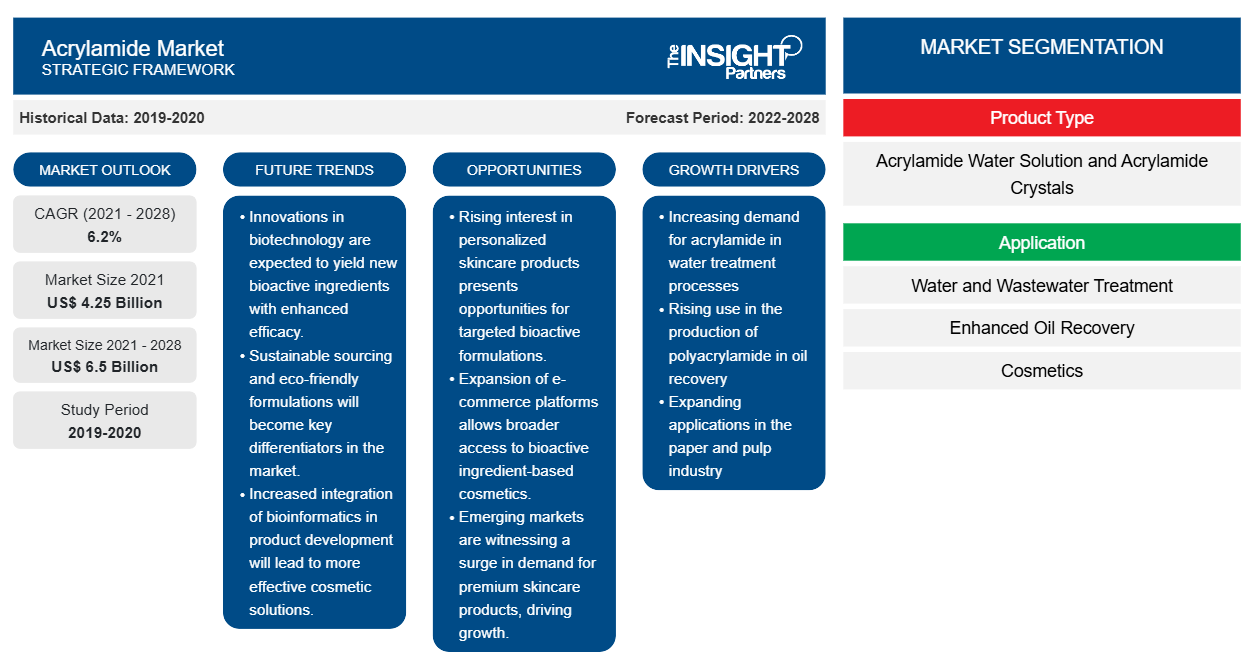Se espera que el mercado de acrilamida crezca de US$ 4.254,16 millones en 2021 a US$ 6.500,22 millones en 2028; se estima que crecerá a una CAGR del 6,2% entre 2021 y 2028.
La acrilamida es una sustancia química orgánica e inodora que se encuentra disponible en forma líquida y cristalina. Es soluble en agua y en diversos solventes orgánicos. Es un precursor de las poliacrilamidas que tienen varias aplicaciones como espesantes solubles en agua y agentes de floculación.
En 2020, Asia Pacífico dominó el mercado mundial de acrilamida y se espera que mantenga su dominio durante el período de pronóstico. Japón y China son los principales fabricantes de acrilamida y representan una parte importante de la capacidad instalada mundial. El aumento del apoyo gubernamental al tratamiento de aguas residuales en países como India y China, y la creciente industria del cuidado personal y la cosmética en la región están impulsando el crecimiento del mercado en Asia Pacífico. La industria del cuidado personal en la región está creciendo debido al aumento de la población de ingresos medios, el aumento del ingreso per cápita, la mejora del nivel de vida y el aumento de la población de mujeres trabajadoras. Por lo tanto, la creciente industria del cuidado personal ha provocado un aumento de la demanda de acrilamida, ya que se usa ampliamente como estabilizador, aglutinante y espesante en cosméticos y productos de cuidado personal. Junto con esto, se espera que América del Norte sea la segunda región de más rápido crecimiento, lo que se debe al aumento de la inversión en el tratamiento de aguas residuales, así como a un aumento de la demanda de acrilamida del sector de la recuperación mejorada de petróleo y la cosmética. También se espera que Europa sea testigo de un crecimiento considerable durante el período de pronóstico.
Personalice este informe según sus necesidades
Obtendrá personalización en cualquier informe, sin cargo, incluidas partes de este informe o análisis a nivel de país, paquete de datos de Excel, así como también grandes ofertas y descuentos para empresas emergentes y universidades.
-
Obtenga las principales tendencias clave del mercado de este informe.Esta muestra GRATUITA incluirá análisis de datos, desde tendencias del mercado hasta estimaciones y pronósticos.
Perspectivas del mercado
Demanda creciente de tratamiento de aguas residuales
El fuerte crecimiento económico, el aumento de la población y la rápida urbanización en todo el mundo han provocado un aumento del consumo de agua potable y de la generación de aguas residuales. Varios países han aplicado normas estrictas contra la contaminación de los cuerpos de agua y el vertido ilegal de aguas residuales. En países como China, que sufre la contaminación del aire, se han aplicado leyes especiales para protegerlo del impacto nocivo del vertido de aguas residuales. La gestión de las aguas residuales industriales se ha convertido en una preocupación crucial entre los organismos reguladores, ya que los efluentes industriales incluyen productos químicos nocivos que pueden provocar riesgos para la salud y perjudicar la biodiversidad marina. Por tanto, el aumento de la demanda de tratamiento de aguas residuales en todo el mundo está impulsando el crecimiento del mercado.
Información sobre el tipo de producto
Según el tipo de producto, el mercado se divide en soluciones acuosas de acrilamida y cristales de acrilamida. En 2020, el segmento de cristales de acrilamida fue el de mayor crecimiento en el mercado de la acrilamida. Los cristales de acrilamida tienen diversas aplicaciones y se utilizan como floculante, agente de bloqueo, agente de tratamiento textil y agente de tratamiento de agua.flocculant, blocking agent, textile treatment agent, and water treatment agent.
Ashland Global Holding Inc.; SNF; Kemira OYJ; BASF SE; EMCO Dyestuff; Mitsui Chemicals Global, Pvt. Ltd.; Ineos AG; Solvay; Nuoer Group; y Black Rose Industries Ltd.; se encuentran entre los actores clave que operan en el mercado global. Los principales actores adoptan varias estrategias, como fusiones y adquisiciones, y lanzamientos de productos, para expandir su presencia geográfica y su base de consumidores.
Perspectivas regionales del mercado de acrilamida
Los analistas de Insight Partners explicaron en detalle las tendencias y los factores regionales que influyen en el mercado de la acrilamida durante el período de pronóstico. Esta sección también analiza los segmentos y la geografía del mercado de la acrilamida en América del Norte, Europa, Asia Pacífico, Oriente Medio y África, y América del Sur y Central.

- Obtenga datos regionales específicos para el mercado de acrilamida
Alcance del informe de mercado de acrilamida
| Atributo del informe | Detalles |
|---|---|
| Tamaño del mercado en 2021 | 4.250 millones de dólares estadounidenses |
| Tamaño del mercado en 2028 | 6.500 millones de dólares estadounidenses |
| CAGR global (2021-2028) | 6,2% |
| Datos históricos | 2019-2020 |
| Período de pronóstico | 2022-2028 |
| Segmentos cubiertos |
Por tipo de producto
|
| Regiones y países cubiertos |
América del norte
|
| Líderes del mercado y perfiles de empresas clave |
|
Densidad de actores del mercado de acrilamida: comprensión de su impacto en la dinámica empresarial
El mercado de la acrilamida está creciendo rápidamente, impulsado por la creciente demanda de los usuarios finales debido a factores como la evolución de las preferencias de los consumidores, los avances tecnológicos y una mayor conciencia de los beneficios del producto. A medida que aumenta la demanda, las empresas amplían sus ofertas, innovan para satisfacer las necesidades de los consumidores y aprovechan las tendencias emergentes, lo que impulsa aún más el crecimiento del mercado.
La densidad de actores del mercado se refiere a la distribución de las empresas o firmas que operan dentro de un mercado o industria en particular. Indica cuántos competidores (actores del mercado) están presentes en un espacio de mercado determinado en relación con su tamaño o valor total de mercado.
Las principales empresas que operan en el mercado de acrilamida son:
- INEOS Styrolution India Limited
- Compañía: Ashland Global Holdings Inc.
- Enfermería no especializada
- Compañía Kemira
- BASF SE
Descargo de responsabilidad : Las empresas enumeradas anteriormente no están clasificadas en ningún orden particular.

- Obtenga una descripción general de los principales actores clave del mercado de acrilamida
Informe Destacado
- Tendencias progresivas en la industria de la acrilamida para ayudar a los actores a desarrollar estrategias efectivas a largo plazo
- Estrategias de crecimiento empresarial adoptadas por las empresas para asegurar el crecimiento en los mercados desarrollados y en desarrollo
- Análisis cuantitativo del mercado mundial de acrilamida de 2019 a 2028
- Estimación de la demanda de acrilamida en diversas industrias
- Análisis de Porter para ilustrar la eficacia de los compradores y proveedores que operan en la industria para predecir el crecimiento del mercado.
- Desarrollos recientes para comprender el escenario competitivo del mercado y la demanda de acrilamida
- Tendencias y perspectivas del mercado junto con los factores que impulsan y restringen el crecimiento del mercado de acrilamida
- Comprensión de las estrategias que sustentan el interés comercial con respecto al crecimiento del mercado global de acrilamida, ayudando en el proceso de toma de decisiones.
- Tamaño del mercado de acrilamida en varios nodos del mercado
- Descripción detallada y segmentación del mercado mundial de acrilamida, así como su dinámica industrial
- Tamaño del mercado de acrilamida en varias regiones con oportunidades de crecimiento prometedoras
El "Análisis del mercado global de acrilamida hasta 2028" es un estudio especializado y profundo de la industria de productos químicos y materiales, que se centra en el análisis de las tendencias del mercado global de acrilamida. El informe tiene como objetivo proporcionar una descripción general del mercado con una segmentación detallada del mercado. El mercado de acrilamida está segmentado en función del tipo de producto, la aplicación y la geografía. Según el tipo de producto, el mercado se bifurca en solución de agua de acrilamida y cristales de acrilamida. Según la aplicación, el mercado se segmenta en tratamiento de agua y aguas residuales, recuperación mejorada de petróleo , cosméticos, fabricación de papel, productos químicos intermedios, textiles y otros. Según la geografía, el mercado está segmentado en cinco regiones principales: América del Norte, Europa, Asia Pacífico, Oriente Medio y África, y América del Sur y Central. La acrilamida se utiliza para fabricar polímero de acrilamida (poliacrilamida) que se utiliza como floculante en el tratamiento de aguas residuales. Coagula la materia orgánica que se puede eliminar por filtración. El creciente desarrollo de instalaciones de tratamiento de aguas residuales en todo el mundo está incrementando la demanda de acrilamida.
Perfiles de empresas
- Compañía: Ashland Global Holding Inc.
- Enfermería no especializada
- Kemira OYJ
- BASF SE
- Colorante EMCO
- Compañía química Mitsui Global, Pvt. Ltd.
- Ineos AG
- Solvay
- Grupo Nuoer
- Industrias Rosa Negra Ltd.;
- Análisis histórico (2 años), año base, pronóstico (7 años) con CAGR
- Análisis PEST y FODA
- Tamaño del mercado, valor/volumen: global, regional y nacional
- Industria y panorama competitivo
- Conjunto de datos de Excel
Informes recientes
Testimonios
Razón para comprar
- Toma de decisiones informada
- Comprensión de la dinámica del mercado
- Análisis competitivo
- Información sobre clientes
- Pronósticos del mercado
- Mitigación de riesgos
- Planificación estratégica
- Justificación de la inversión
- Identificación de mercados emergentes
- Mejora de las estrategias de marketing
- Impulso de la eficiencia operativa
- Alineación con las tendencias regulatorias























 Obtenga una muestra gratuita para - Mercado de acrilamida
Obtenga una muestra gratuita para - Mercado de acrilamida